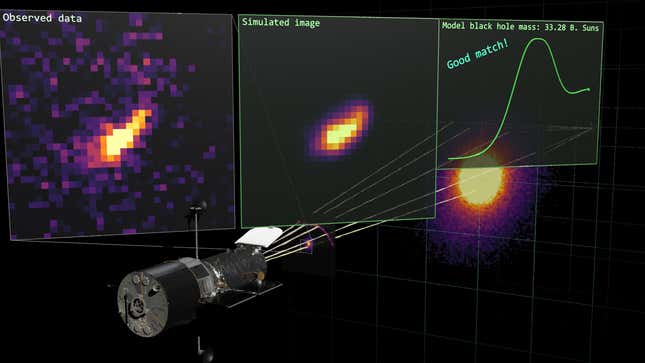Holy smokes. A gaggle of astronomers have discovered a black gap containing (checks notes) 30 billion instances the mass of our Solar. That’s greater than seven thousand instances the scale of the supermassive black gap on the middle of the Milky Method.
The crew used gravitational lensing to see the black gap. On this pure phenomenon, large objects’ gravitational fields bend photons of sunshine magnifying and warping them—making it doable to see object that might in any other case be hidden or too faint. Final 12 months, a team spotted the oldest known star in an arc of gravitationally lensed light.
Based on a Durham College release, the newly detected black gap is the primary ever discovered utilizing gravitational lensing. A paper concerning the discovery is published immediately within the Month-to-month Notices of the Royal Astronomical Society.
“This specific black gap, which is roughly 30 billion instances the mass of our Solar, is without doubt one of the greatest ever detected and on the higher restrict of how giant we imagine black holes can theoretically develop into, so it’s a particularly thrilling discovery,” stated James Nightingale, a physicist at Durham College, within the college launch.
G/O Media could get a fee

up to 70% off
Lenovo Spring Clearance
Deals on deals
Take up to 70% off at Lenovo’s Spring Clearance sale, including a wide range of laptops, monitors, and tablets. Take an extra 15% off with the promo code.
The team identified the black hole by modeling the different pathways light might take through the universe, depending on the presence of black holes of varying mass. They then compared the computer data with images of the cosmos taken by the Hubble Space Telescope. Lo and behold, they found a match.

The biggest known black hole is TON 618, a 40-billion-solar-mass black hole sitting 10.37 billion light-years away, in response to LiveScience. Ultramassive black holes are labeled as these between 10 billion and 40 billion photo voltaic lots, according to NASA.
“Gravitational lensing makes it doable to check inactive black holes, one thing not at the moment doable in distant galaxies,” Nightingale added. “This method may allow us to detect many extra black holes past our native universe and reveal how these unique objects developed additional again in cosmic time.”
In different phrases, even these black holes quietly lurking in house—not the lively galactic nuclei which can be accreting superheated materials and spewing vitality out into house—may be studied and included into black gap datasets.
Discovering extra black holes of such gargantuan scale may additionally assist astrophysicists work out a permanent puzzle: precisely how black holes develop and what defines the bounds of their measurement.
Clarification: Resulting from an modifying error, an earlier model of this text acknowledged that the newly found black gap is “greater than seven instances the scale of the supermassive black gap on the middle of the Milky Method.” Whereas that’s technically correct, the black gap is in truth over 7,000 instances the scale of the Milky Method’s central black gap.
More: Astronomers Spot Two Supermassive Black Holes on a Collision Course
Trending Merchandise

Cooler Master MasterBox Q300L Micro-ATX Tower with Magnetic Design Dust Filter, Transparent Acrylic Side Panel…

ASUS TUF Gaming GT301 ZAKU II Edition ATX mid-Tower Compact case with Tempered Glass Side Panel, Honeycomb Front Panel…

ASUS TUF Gaming GT501 Mid-Tower Computer Case for up to EATX Motherboards with USB 3.0 Front Panel Cases GT501/GRY/WITH…

be quiet! Pure Base 500DX Black, Mid Tower ATX case, ARGB, 3 pre-installed Pure Wings 2, BGW37, tempered glass window

ASUS ROG Strix Helios GX601 White Edition RGB Mid-Tower Computer Case for ATX/EATX Motherboards with tempered glass…










